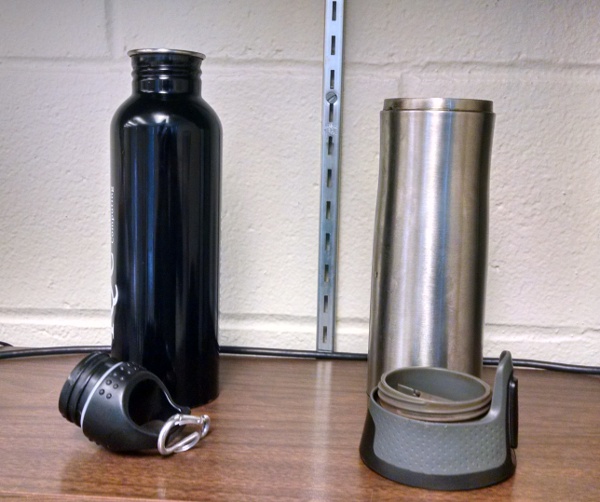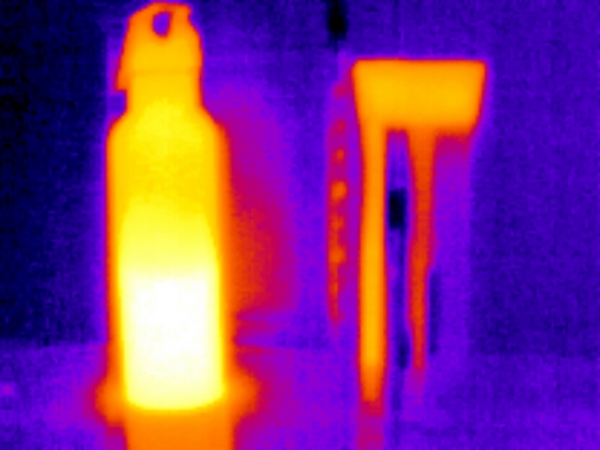One of my favorite Christmas presents this year was a Seek Thermal camera to use with my Android phone. This allows for a lot of idle physics-y fun, taking pictures of things in thermal mode.
One idea I had was to do a sort of follow-up to the test of my insulated mug that I did a couple of years ago with a PASCO thermocouple probe. That showed a really dramatic difference between my metal IQC water bottle and the insulated mug, in terms of the rate at which hot water placed in each cooled. So, how do these look in thermal imaging?
Well, I took my insulated mug (actually a different one than the old test, because I dropped that one too many times, and the lid got damaged, so I only use it as a back-up) and my metal water bottle, and filled them both halfway up with hot water from the department water cooler. This produced the following visible-light image:
 Visible-light image of my metal water bottle and insulated coffee mug, each half-full with hot water.
Visible-light image of my metal water bottle and insulated coffee mug, each half-full with hot water.
Thrilling, no?
With the thermal camera, they look like this (after 15 minutes or so of sitting on a shelf equilibrating):
 Thermal image of my metal water bottle (left) and my insulated coffee mug, both half-full with hot water. Taken with a Seek Thermal camera on my Android phone.
Thermal image of my metal water bottle (left) and my insulated coffee mug, both half-full with hot water. Taken with a Seek Thermal camera on my Android phone.
Again, the answer to the question "How good is my mug?" is "Very." While you can easily see the hot water level inside the thin-walled water bottle, you really can't see anything in the insulated mug. The only reasons you can see it at all are 1) the rubberized cap shows as warmer than the surroundings, and 2) it's reflecting some of the thermal radiation from the water bottle next to it.
There's a lot of fun physics in this, starting with the fact that you can see the different levels, which probably has less to do with a temperature difference between the water and the air above it, than the heat capacity of the two. The water and air are probably close to the same temperature (the difference is more pronounced with the cap off), but the water is much more effective at heating the metal. And there's also the big difference between the rubberized cap and the steel of the insulated mug, which has to do with some material properties (either heat capacity or emissivity, not sure).
So, anyway, it's a fun toy. If you have an Android phone and a love of physics (and a couple hundred bucks you need to spend), I recommend picking one up.

I should think the shiny metal surface has a emissivity that is not in the least like that of a black body. The paint on the water bottle is very likely to be a black-body emitter, in contrast.
Try putting a strip of masking tape on the shiny mug and repeating the experiment. The insulation will still show its effect, but at least the emissivity spectra of the two vessels are equal.
Just before Christmas, Apple finally got around to approving the device for iPhones, so it was my Christmas present to myself.
The Seek Thermal camera is fun, and practical. I've used it to find leaks in my heating ducts, and places where insulation has shifted in my attic. Over a few Winters it will probably have paid for itself.
Thanks for the heads up. Ten years ago our volunteer fire dept came into some FEMA money and we bought an ISI Thermal Imaging Camera for $10,000. It's been nothing but trouble - heavy awkward construction, short lived batteries that run the cost of this little camera and an on/off switch that stopped working (fortunately in on mode).
I think I'll look into this. I'm not sure I see a downside unless it's sensitivity.